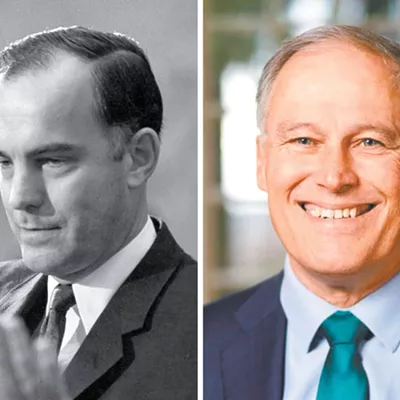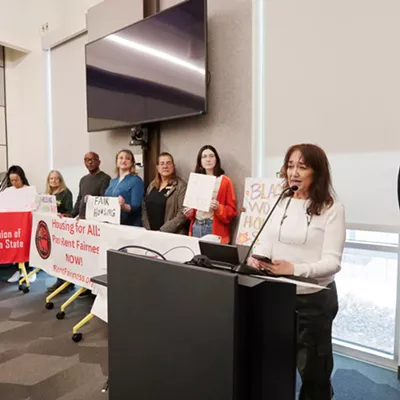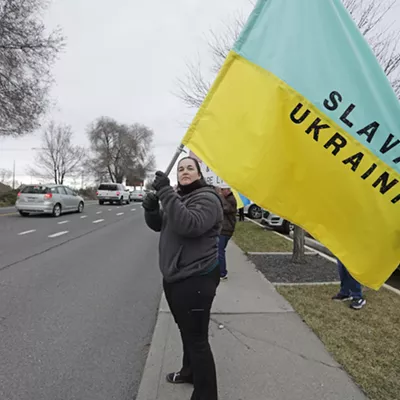
Tired of elections? Too bad. Spokane has another one happening on Feb. 13. If you haven't gotten a ballot in the mail yet, click here.
In addition to a school and library levy, Spokane voters will be asked to consider a charter amendment — called Measure 2 — that would change the city's redistricting process.
"It's not always the sexiest topic," Council member Paul Dillon acknowledged on Monday. "But it's one that certainly impacts all of us."
On Monday, City Council members passed a resolution formally expressing their support for Measure 2.
While voting, Council members Zack Zappone and Michael Cathcart said they were frustrated that Measure 2 hadn't received more media coverage, and directly called out reporters in the audience. They said the had been getting questions from people who were confused about what Measure 2 actually does.
"The media hasn't been covering this," Zappone said.
(For what it's worth, we wrote an article about the measure in December. The Spokesman-Review wrote about it here, here, here and here. Spokane Public Radio reported on it here. KHQ covered it here; and RANGE Media has mentioned it several times in its civics newsletter.)
But still, the measure has a lot of technical details, and it's understandable that some voters may still be looking for more information. In the interest of democracy, here's a simple guide to Measure 2.
IN A NUTSHELL
Measure 2 asks voters if they want to change the Spokane's City Council district boundaries are drawn.
The goal is to improve public trust by increasing community involvement and protecting the redistricting process from partisanship and gerrymandering.
The measure would make several key changes to the city's law:
- Expand the city's redistricting commission from three members to seven.
- Create firmer restrictions to limit the involvement of lobbyists and other political actors.
- Make it a priority to keep neighborhoods intact while drawing district boundaries.
- Require more public engagement.
- Restrict the City Council from modifying maps proposed by the redistricting commission.
- Create a process for citizens to request a mid-decade redistricting process.
The measure has support from both conservative and liberal council members. They say it's a sign that the changes are intended to make the process fair and neutral — not to benefit any political party.
Cathcart, who leans conservative, and Zappone, who leans liberal, co-wrote the "argument for" statement that appears on the voter's guide. They say Measure 2 will help establish a redistricting process rooted in "fairness, inclusivity, and transparency."
The "argument against" section of the voter's guide is empty because nobody volunteered to write it.
WHAT IS REDISTRICTING?
Spokane is divided into three City Council districts. Each district elects two representatives. Click here to see which district you live in and who your representatives are.
The district boundaries are adjusted by the city's redistricting commission every 10 years to account for population changes. Under the current law, the redistricting commission is made up of three volunteers who are appointed by the mayor and approved by the City Council.
When drawing boundaries, the redistricting commission has to balance the competing goals of keeping populations roughly equal, following geographic boundaries when possible and keeping neighborhoods intact.
The commission typically drafts a number of maps, and then sends its top picks to City Council. As required by state law, the City Council has the final vote on which map to adopt.
The process is supposed to be totally neutral and nonpartisan, but that can be easier said than done.
Spokane City Council elections sometimes come down to just a few hundred votes. A simple change to the map — like moving a liberal neighborhood like Browne's Addition from one district to another — could hypothetically be enough to influence the outcome of an election.
Measure 2 aims to remove City Council members and other politically-biased actors from the map-making process.
WHY ARE WE VOTING ON THIS?
The redistricting process in 2022 was messy. It prompted a lawsuit, ethics complaint and allegations of gerrymandering.
In addition to its three appointed volunteers, the redistricting commission had two advisory members: Zappone and former Council President Breean Beggs.
The three board members drafted more than a dozen maps. Zappone also drew a map of his own and presented it to the commission. The commission recommended that the City Council adopt one of the maps drawn by its members, but City Council members instead voted 4-2 to adopt the map drafted by Zappone.
This was controversial.
The map drawn by Zappone accomplished the goals of keeping populations equal and neighborhoods mostly intact, but it also moved the reliably-liberal Browne's Addition neighborhood into northwest Spokane's District 3, giving progressive candidates like Zappone a small but not-insignificant advantage. Subpoenaed text messages later showed Zappone discussing the partisan implications of the map with political allies.
Zappone denies doing anything wrong. Last Spring, Spokane County Superior Court Judge Tony Hazel ruled that Zappone didn't violate the law. But Hazel also said the city charter had "ambiguous" language, and that the city should create a process that "removes all questions of self-interest or partisanship."
After Hazel's ruling, Cathcart began working on the charter amendment to fix the process. Measure 2 asks voters whether or not they want to adopt the charter amendment.
"At the end of the day, my goal is: Let's keep council out of this, let's give citizens the best, strongest voice possible," Cathcart says.
WHAT DOES THE AMENDMENT ACTUALLY DO?
Measure 2 would repeal two sections of the city charter and replace it with a brand new one. The new section has some similarities to the previous laws, but it also has some big differences:
Expand the redistricting board from three members to seven:
The proposed charter amendment says the city clerk will be responsible for soliciting candidates who want to serve on the redistricting commission.
From that pool of applicants, the mayor will be in charge of choosing three, one from each district. The City Council will also vote to appoint one from each district. The mayor can’t veto the council’s choice, and the council can’t override the mayor’s choice.
The six people appointed by council and the mayor will then choose a seventh, non-voting chairperson from the remaining pool of applicants.
The amendment also stipulates that the mayor and City Council should strive to consider demographic and geographic diversity when appointing people.
“It ensures that citizens are the ones coming up with the map,” Cathcart says. “The citizens, at the end of the day, are approving the maps.”
The proposed charter language also removes City Council members’ role as advisory members on the commission.
New membership requirements
Anyone who is registered to vote and has lived in Spokane for at least two years is eligible to apply to the board.
To prevent conflicts of interest, the proposed amendment strengthens the city’s restrictions against lobbyists and other political actors:
- People can’t serve on the board if they were a registered lobbyist in the past two years.
- Candidates can’t serve if they’ve held any elected office in the past two years, or if they’re actively in office. (This doesn’t apply to precinct committee officers.)
- Candidates can’t actively campaign for elected office, or actively participate or raise money for political campaigns.
- Candidates can’t seek election or appointment to a City Council position for two years after the redistricting process.
Drawing the map
The board will use the most recently available census data to draw maps that are consistent with Washington state law.
The proposed charter amendment also says that keeping neighborhoods intact is a priority when drawing maps.
Public process
The current law says the redistricting board has to hold at least three public hearings where citizens can give feedback. The proposed amendment increases the number of public hearings to five.
“It just makes sense to provide some additional avenues for people to hear what's being proposed, engage in what’s being proposed, and provide their input into the process,” Cathcart says.
By Aug. 1, the board has to choose five preliminary redistricting maps and allow at least 30 days for public review and comment.
Picking the map
By Oct. 1, the board has to vote on its top pick for a map and send the map to the City Council. The proposed amendment says that, if the commission can’t agree on a map, a municipal court judge gets to choose.
The City Council then evaluates and votes on whether or not to adopt the commission’s proposed map. To prevent a repeat of 2022, the amendment bars council from modifying the commission's proposal or choosing a map that the commission didn’t suggest.
If the City Council can’t agree on the map, it gets sent back to the commission for changes.
A final map has to be adopted by Nov. 15. If an agreement isn’t reached by then, a municipal court judge steps.
Mid-decade redistricting
The redistricting process normally happens every decade. But in the event of significant population changes, the City Council has the authority to launch a mid-decade redistricting process.
The proposed charter amendment would create a process for citizens themselves to initiate a mid–decade redistricting process. The mid-decade redistricting would be triggered by a citizen petition signed by 10% of recent voters.
“A citizen group can basically say, ‘Hey, we want to kick start this and get the ball rolling,’” Cathcart says.
After the city adopts a redistricting map, any registered voter can file a petition with the Spokane County Superior Court challenging the plan.




























